A real-deal dan dan noodle recipe that stays true to the authentic Sichuan flavor. This post covers all the key ingredients and includes a super rich and balanced sauce to recreate the classic dish that tastes like China.
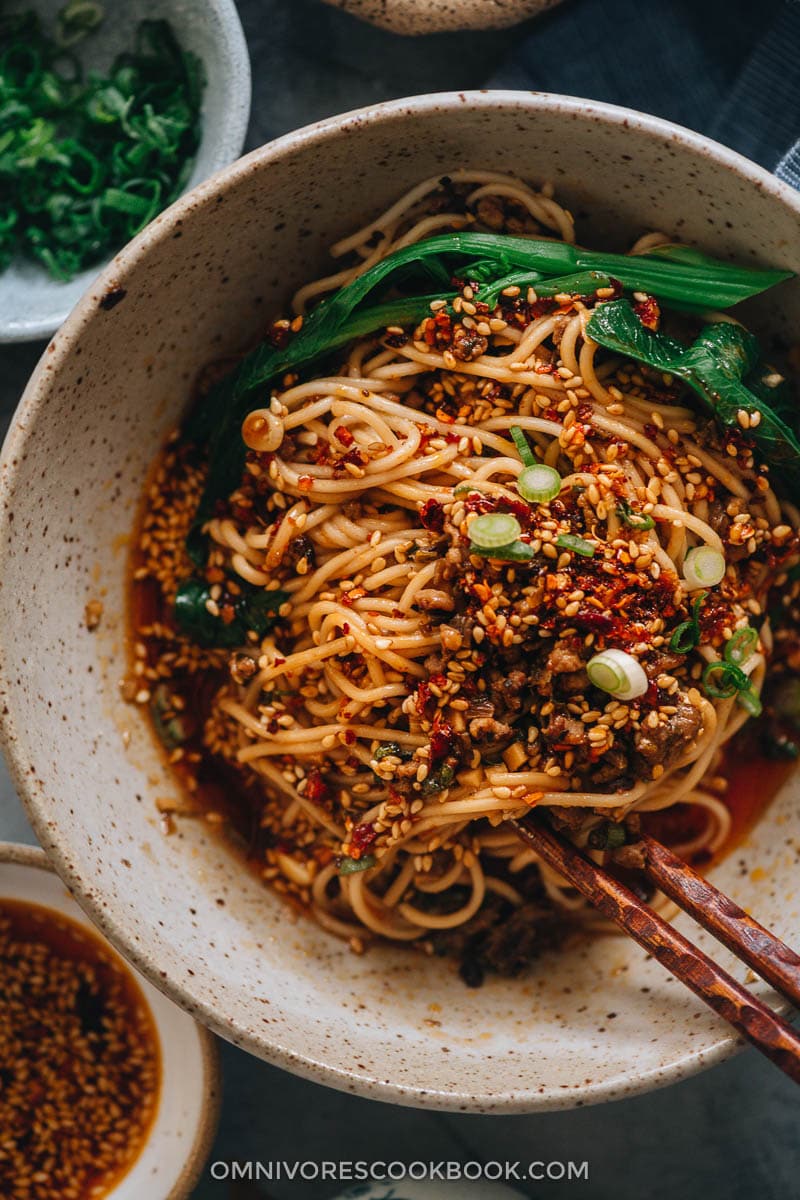
Dan dan Noodles is such a classic dish that is really worth the effort to master. I’ve been improving the recipe since I first published it back in 2014, and this is the third version.
You can head straight to the recipe if you already know the dish. If you are new to Chinese cooking, I recommend browsing the post first so you can learn about the ingredients and pick up a few helpful cooking tips that support the Authentic Chinese noodle recipes collection.
What are Dan Dan Noodles?
Dan Dan Noodles (担担面, dan dan mian) are one of the most famous of Sichuan street foods. The freshly boiled thin noodles are served in a savory, spicy sauce topped with crispy pork and peanut flakes. Simply stir everything together with a pair of chopsticks to coat the noodles with a bit of everything and slurp! The numbing, smoky, spicy sauce will shock your taste buds, leaving you craving for more.
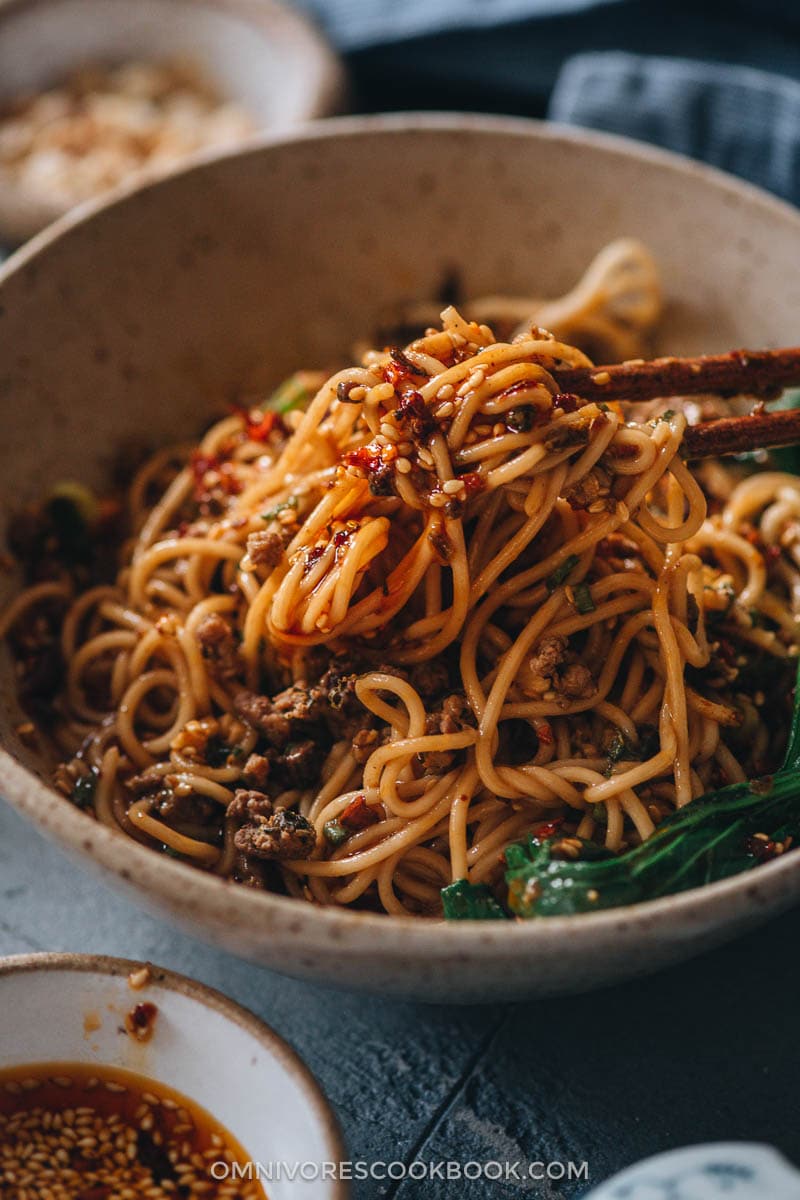
When you go into different restaurants, you’ll find each chef has their own interpretation on dan dan noodles.
In Sichuan restaurants in China, the dan dan noodle dish is more of a snack than a main and is usually served in a small bowl. The noodles are mostly immersed in a thick red broth made with chili oil, with a small amount of pork on top. The dish can sometimes be more soupy and very spicy, but it depends on the chef.
After the dish was introduced in the US, it was transformed and now looks more like a pasta dish — boiled noodles with a meat sauce on top. Sometimes the sauce is more sweet and sour than spicy, almost like a General Tso stir fry (e.g. the Dan dan noodles at Pei Wei). Sometimes the chef will mix Chinese sesame paste into the chili oil to make the sauce creamier and mellow out the spiciness.
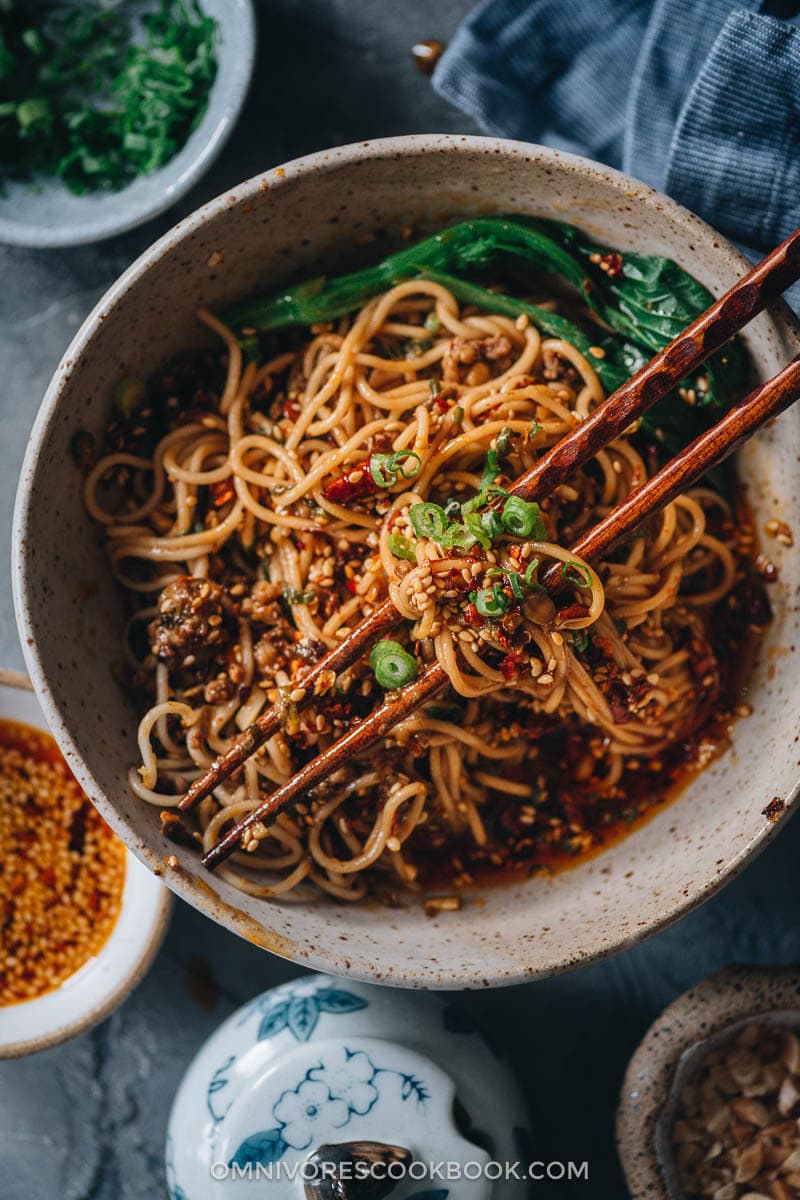
My own interpretation of dan dan noodles
When I make dan dan noodles at home, I use an approach that is 80% true to the original version from Sichuan. You get the ultra-umami, spicy and numbing-ness coming from the fried pork, pickled mustard greens, homemade chili oil, and Sichuan peppercorns. But I also mix in some sesame paste to make the sauce creamier and more appealing to anyone who prefers milder food.
Key ingredients
Sui Mi Ya Cai – or preserved mustard green
Sui Mi Ya Cai (碎米芽菜) is a must-have ingredient if you want to call a dish dan dan noodles in China. It is a type of cardamine bean sprout that is native to Sichuan. It is dried, flavored with sugar and spices, and fermented. The end result is a dark brown pickle that has a crunchy texture and a one-of-a-kind taste — a bit sweet, salty, and savory, with an earthy umami.
It can be tricky to find Sui Mi Ya Cai, since it’s a specialty ingredient, even in China. You can usually find it in the un-refrigerated section of the Asian supermarket with the pickles. If you do not live near an Asian market you can also purchase it on Amazon.
NOTE: It’s totally possible to create a delicious bowl of dan dan noodles without this ingredient.
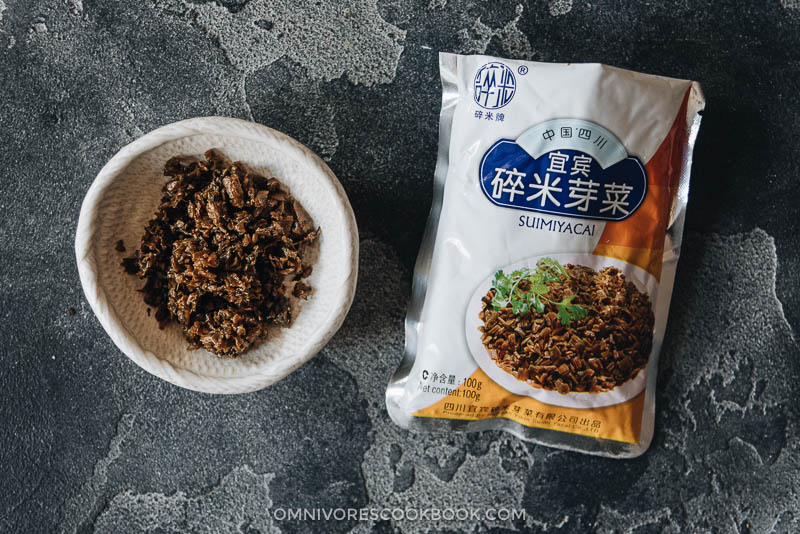
Homemade chili oil
Chili oil is a staple in every family household in Sichuan and the homemade version is a must. It is the main ingredient in dan dan noodles and I highly recommend you make your own. Making chili oil might look daunting at first, but trust me, it only takes 5 minutes. Check out this post to learn how.
NOTE: to anyone who prefers not to eat spicy food — you will still benefit from the homemade chili oil. When you’re making the noodle sauce, you can add a small amount of chili oil to infuse aroma and smokiness; your dish won’t end up very spicy.
Chinese sesame paste
Chinese sesame paste (芝麻酱, zhi ma jiang) is a thick paste made from toasted sesame seeds. Although a lot of original Sichuan dan dan noodle recipes do not contain this ingredient, I prefer to use it to make the sauce creamier. It also balances the spiciness to round out the flavor. It adds great umami too, so your sauce will still taste great if you don’t want to add too much chili oil.
You can find Chinese sesame paste in most Asian grocery stores, or purchase it online. I prefer the sesame paste made with 100% sesame seeds, which has a better taste. You can also find cheaper sesame pastes made from a blend of sesame and peanuts.
NOTE: Chinese sesame paste tastes VERY different from tahini. Do not use tahini as an alternative. If you don’t want to purchase Chinese sesame paste, you can also use natural peanut butter with a few teaspoons of sesame oil mixed in.
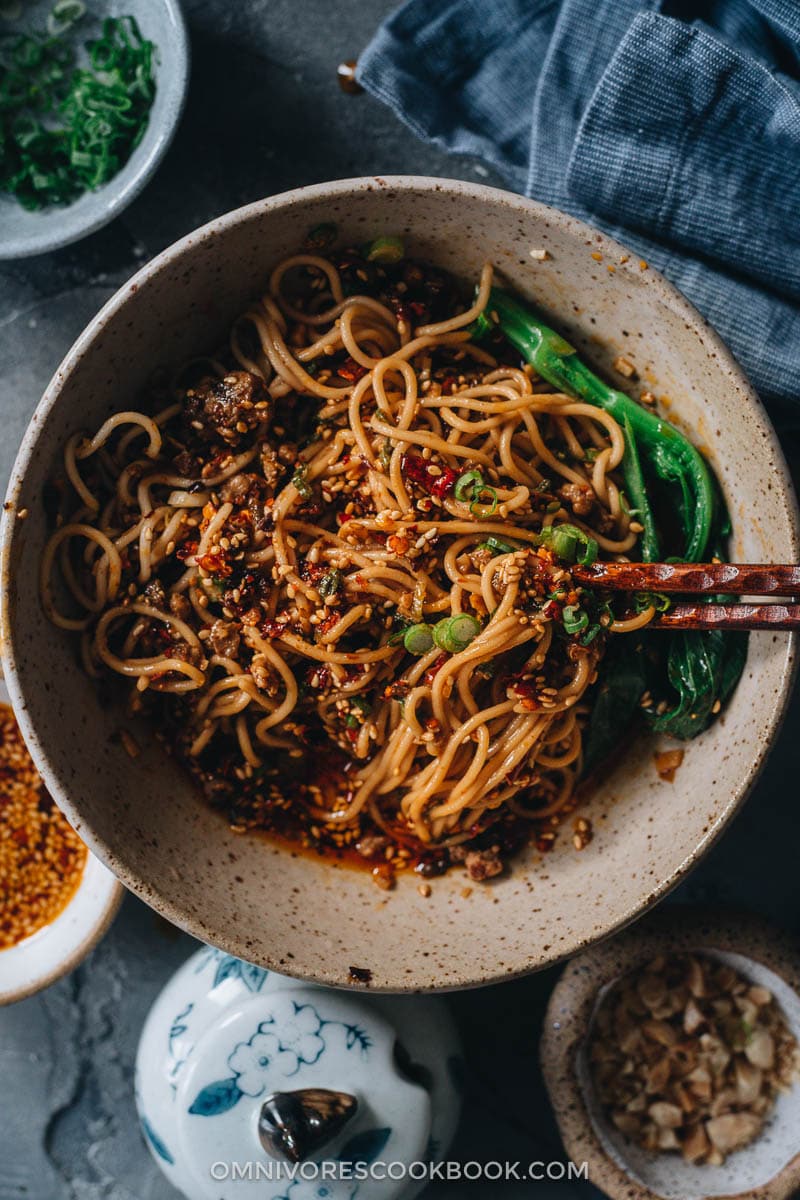
Cooking notes
What type of noodles to use
Dan dan noodles usually use the thin type of wheat noodles. Although it’s usually just a tad thicker than somen noodles. If you’re lucky, you might be able to find the semi-fresh Dan Dan noodles in the refrigerated section in an Asian market. Or you can use any type of dried noodle that is made with wheat and on the thin side.

How to mix the sauce properly
If this is your first time cooking with Chinese sesame paste, you will usually find it is separated into oil on top and thick paste underneath. To make it easy to use, stir the sesame paste thoroughly in the jar to incorporate the oil with the paste. Without this step, you will find the sesame paste very thin on the top of your jar and very dry on the bottom.
Sesame paste has a tendency to thicken when you stir in the liquid. The best way to mix the sauce is to add the sesame paste first, then mix in the liquid ingredients little by little. Whisk the mixture with a pair of chopsticks (or a spoon) until the solid paste is fully blended with the liquid. Then add more liquid and repeat, so everything will dissolve evenly.
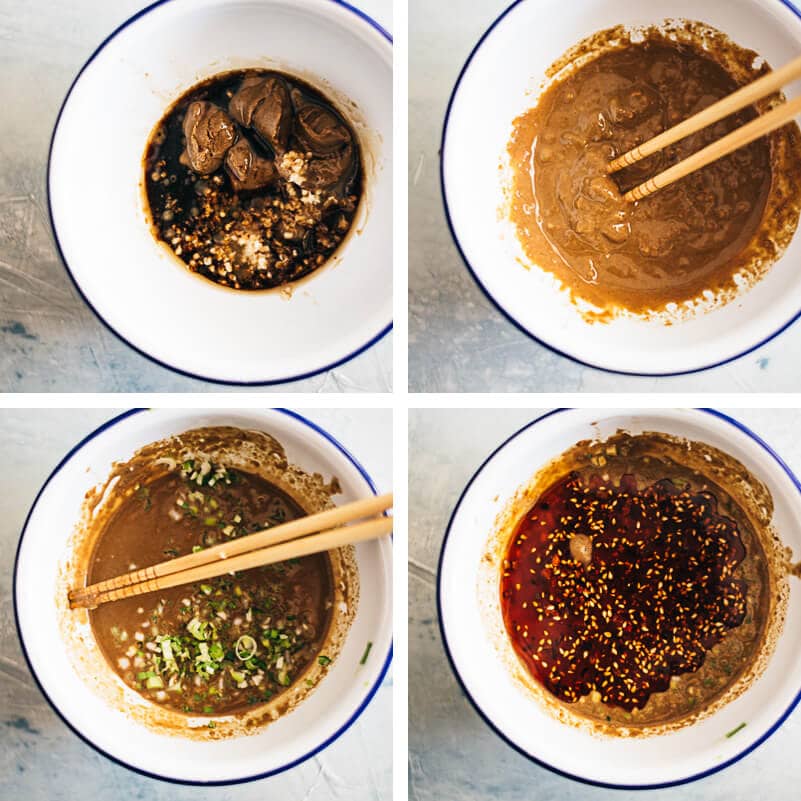
How to fry the pork properly
To properly prepare the pork for dan dan Noodles, you’ll need to “overcook” the pork.
Use medium-high heat to cook brown surface first, then turn to medium heat to let it roast until the liquid in the meat is fully released and evaporated.
In the end you will have dark-brown colored pork without adding any soy sauce. The pork bits will be a bit chewy and have an almost-crispy texture when hot.
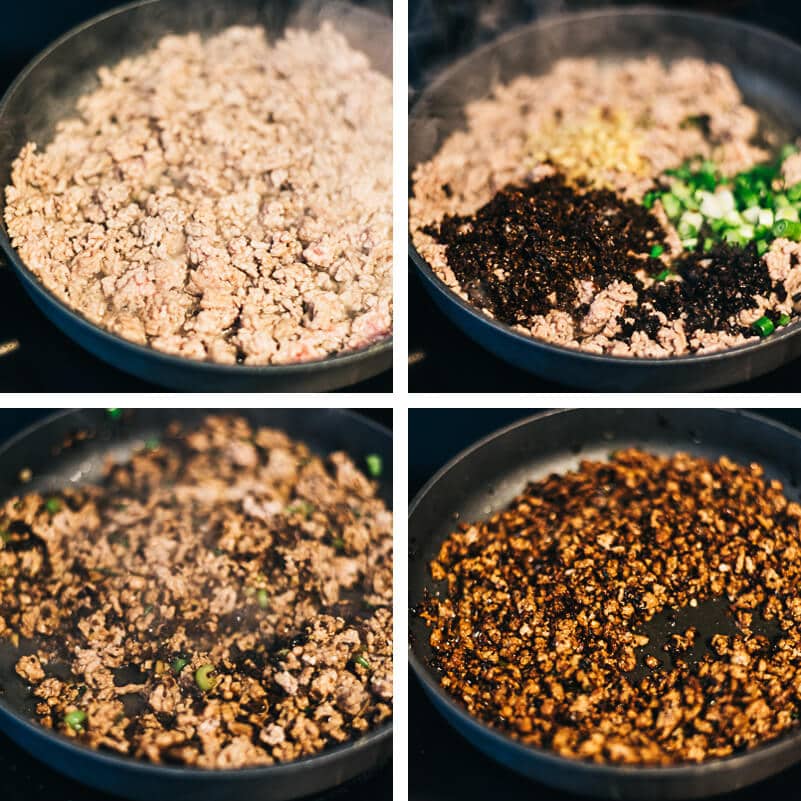
The best workflow
The ingredient list for dan dan noodles might look overwhelming,. The best approach is to get organized and cook one component at a time.
The best workflow is:
- Chop and prep all the vegetables and aromatics
- Mix the sauce (and make chili oil if needed) – this can be prepared ahead
- Cook the pork – Can be prepared ahead
- Boil the noodles
- Use the noodle-boiling water to quickly blanch the vegetables
- Serve everything family-style, so everyone can assemble their noodles the way they like
If you’re preparing this dish for a party, I highly recommend you prepare the sauce and the pork ahead of time. They will stay good in the fridge for a couple of days. Simply boil the noodles and heat up the pork in the microwave right before serving.
To assemble dan dan noodles like a local
To assemble dan dan noodles like a Chinese street vendor:
- Pour some sauce in a small bowl and chili oil according to your taste
- Add the noodles
- Top with minced pork, green veggies, crushed peanuts, and green onions
- Mix and enjoy!
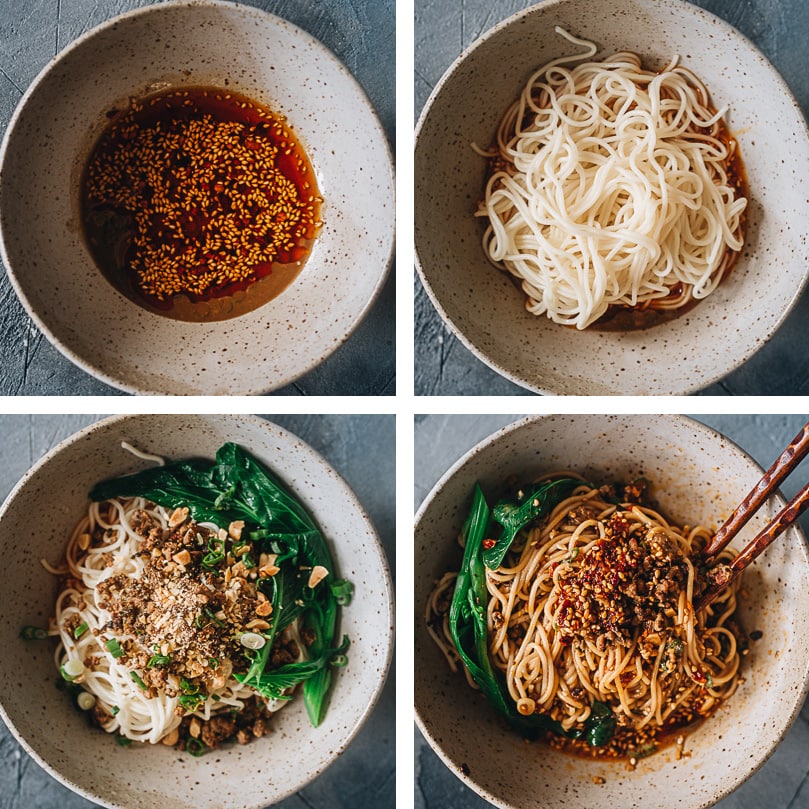
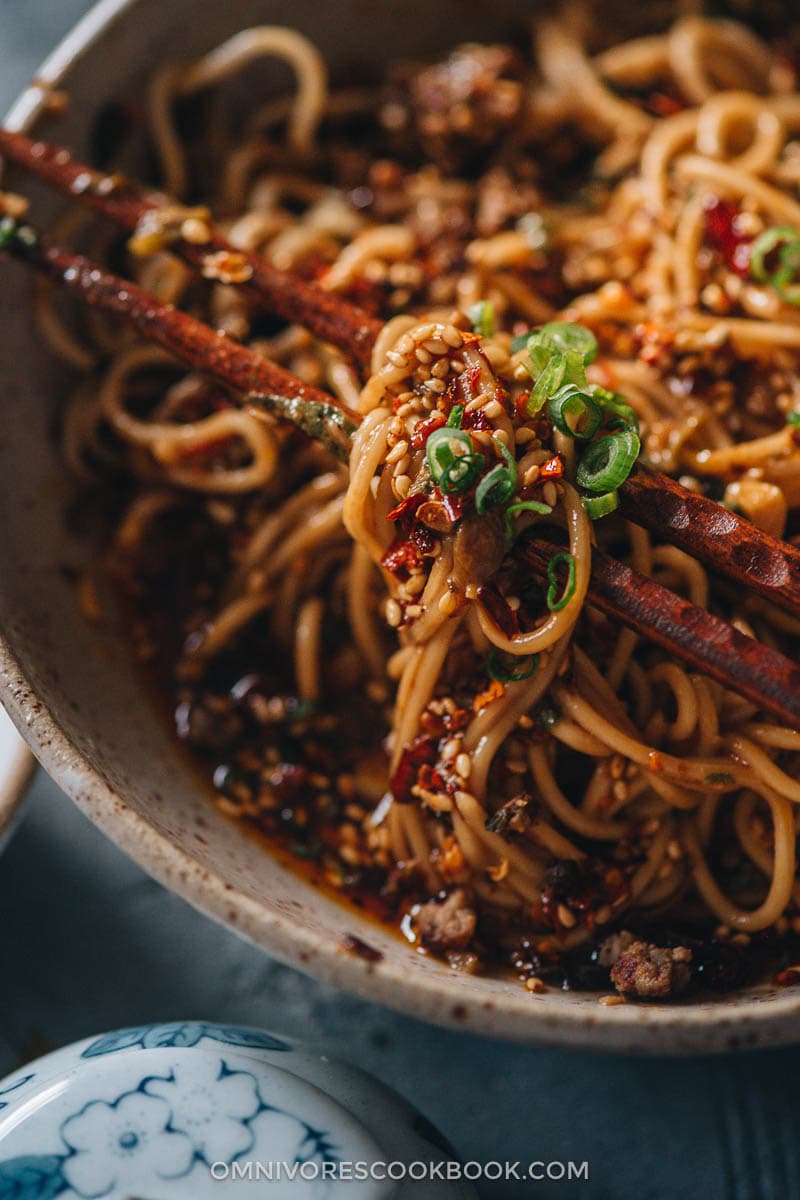
More Sichuan food recipes
- Mapo Tofu
- Sichuan Eggplant Stir Fry
- Dry Fried Green Beans
- Sichuan Mala Chicken
- Sichuan Spicy Wonton in Red Oil
If you give this recipe a try, let us know! Leave a comment, rate it (once you’ve tried it), take a picture and tag it @omnivorescookbook on Instagram! I’d love to see what you come up with.
Chinese Cooking Made Easy
Are you new to this website? This free email series is a great place to start. I’ll walk you through a few of my most popular recipes and show you how and why they work. You’ll quickly start to cook better Chinese food in your own kitchen.
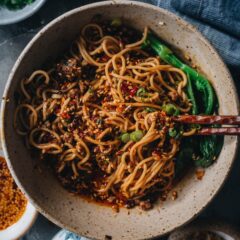
Dan Dan Noodles (担担面)
Ingredients
Noodle sauce
- 1/3 cup Chinese sesame paste (or unsweetened natural peanut butter)
- 1/3 cup light soy sauce (or soy sauce)
- 1/4 cup Chinkiang vinegar
- 4 cloves garlic , finely minced
- 2 green onion , finely minced
- 2 tablespoons honey (or agave syrup)
- 1/2 to 1 teaspoon Sichuan peppercorns , toasted and grounded (*footnote 2)
Pork topping
- 1 tablespoon peanut oil (or vegetable oil)
- 1 lb ground pork
- 1 tablespoon minced ginger
- 2 green onions , chopped
- 1 1/2 tablespoons fermented black beans , rinsed and chopped
- 1/2 cup Sui Mi Ya Cai (Sichuan preserved mustard greens)
- 2 tablespoons Shaoxing wine (or dry sherry)
- 1/2 teaspoon sugar
To assemble
- 1/3 cup roasted peanuts , crushed
- 14 oz Dan Dan noodles (or thin wheat noodles)
- 1 small batch leafy green vegetables , roughly chopped (spinach, choy sum, baby bok choy etc.)
- Homemade chili oil , to taste (*footnote 1)
Instructions
Prepare sauce
- Whisk the sesame paste and light soy sauce together in a bowl until fully incorporated. Add the Chinkiang vinegar. Continue stirring until mixed. Then mix in the garlic, green onion, honey, and Sichuan peppercorns.
Prepare the pork topping
- Heat the oil in a large nonstick skillet over medium-high heat until hot. Add the pork. Cook and stir until the surface is lightly browned.
- Turn to medium heat. Add the ginger, green onion, fermented black beans, Sui Mi Ya Cai, cooking wine, and sugar. Cook and chop the pork into small pieces, until all the liquid has evaporated and the pork turns a dark brown color. Transfer to a bowl and set aside.
Prepare the noodles
- Cook the noodles according to instructions.
- Briefly blanch the leafy green vegetables, drain, and set aside.
To assemble the noodle bowls
- For each noodle bowl, add 1/4 cup of noodle sauce. Add the chili oil according to your taste. Add some noodles, then top with a few spoonfuls of the cooked pork and green veggies. Garnish with peanut crumbles and chopped green onion. Sprinkle with a pinch of toasted ground Sichuan peppercorn, if you like the numbing taste.
- Serve hot or cold.
Notes
Nutrition

Did you make this recipe?
I’d love to hear how it turned out for you! Please take a moment to leave a 5-star rating ⭐️ and share your thoughts in the comments further down the page. It really helps others discover the recipe too.
The recipe was originally published by Feb. 26, 2015 and updated on Apr. 27, 2017.

Emily JS
Made this today with some small modifications, and loved it! Dan Dan noodles are one of my favorite dishes, so I’m so happy to have a reliable method for them.
My changes:
– omitted mustard greens (didn’t have on hand – will def look for them next time I’m at an Asian market, there are plenty of them nearby)
– used frozen udon noodles (again, had on hand, closest thing in my pantry to hand pulled noodles for texture)
– black bean paste instead of black beans (again, what I had). Might try actual fermented black beans in future after this jar is done.
– I did use homemade chili oil, and so omitted the Sichuan peppercorns (the oil already has a good amount in it).
I made a single serving and wound up using too much sesame paste, but I’m still VERY happy with the results! Also, gotta say that I love your website and have been using it for many Chinese home recipes 🙂
Maggie
Hi Emily, thanks so much for leaving such a thorough review! All those changes you made totally make sense and I think I’d do the same if I do not have access to all the ingredients. Can’t wait to hear what you’ll cook the next 🙂
Bill Zigrang
Maggie,
I note that the most recent link you posted on your newsletter points to the 2017 recipe, not the 3/2020 revision.
Bill Zigrang
Maggie
I updated the recipe so it’s the one from 2017 with minor adjustment (mostly new photos).
sconner
Just made this today and it turned out amazing! Thank you so much for this lovely recipe. I normally get my fix at Malaysia but lately the borders have been closed so I can’t. It’s also a pretty expensive dish where I stay so I’m so happy to finally nail this, after my first try! I did my best to get all the ingredients. I couldn’t find the preserved mustard greens but I found a pretty similar preserved vegetable. It tasted just fine so I guess it’s all good!
Thanks so much once again 🙂
Hannah
Love all the recipes and this one has been a hit with myself and for others! It’s one of my friends favourite dishes and we were glad to have found a good recipe.
I miss China and the food so this blog was a great find!
Made it a few times now, with different noodles and different proteins and it’s very forgiving as long as you get the delicious base correct.
Mella
Will sesame sauce work on this recipe? Found this brand called mizkan sesame sauce. I’m based in Singapore and for some weird reason I can’t find sesame paste here.
Thanks
Maggie
I would use unsweetened peanut butter to replace the sesame paste.
If you cannot find it, the sesame sauce might work but you need to adjust other ingredients (namely soy sauce and vinegar), so the sauce won’t taste too salty.
Alfred m Solish
I got here through the link from sui mi ya Cai. It is for vegan Dan Dan noodles. How can it be vegan if you use pork? BTW we do not eat pork. I love your recipes that do not use that meat.
Maggie
I’m afraid it’s a wrong link! Sorry about that. This is the vegan dan dan noodle: https://omnivorescookbook.com/vegan-dan-dan-noodles/
Rewari
Wow. Just Wow. Dan Dan noodles are one of my favorite restaurant dishes – and hard to come by where I live in Europe. This recipe just nailed it – relatively easy to make and so so good. As I said to my wife after my first bite – “everything about this is exactly how I want it to be.” I can’t wait to make this again. Thanks for the great recipe!
Hannah
Was so excited about making this recipe…even managed to get all the obscure ingredients . It was very delicious, although my sauce seemed very thick, even after I added some noodle water….so I didn’t quite get the slurp I was hoping for….will adjust next time…xx
Laura | Wandercooks
We tried the more soupy version of this dish recently but I’m keen to try your recipe as it looks absolutely mouthwatering! I love the sound of the more drier-style sauce, can almost taste it now. Also I’m loving cooking more with Sichuan peppercorns. 🙂
Wendy Lim
I loved your recipe, they are really good. Appreciate your clear explanation, teaching steps by steps which is so wonderful for beginner to start off. Thank you very much.
Matt
Fantastic recipe. Found it from a google search and glad I went with you. Simple to make but so blooming tasty. Definitely on the repeatable dish list. Three thumbs up.
Charlotte
Growing up in Hong Kong, my favourite dish when I ate out was this. I swapped out the pork for tofu as I’m vegan, and it was absolutely spot on. Really impressed, my family were also delighted! Tastes like home!
NeFlBBG
A new favorite – absolutely delicious and easy to do as well!
Can’t thank you enough for showing us your recipes – especially when there is no real asian takeaway in the Austrian mountains.
Looking forward to trying the next recipe soon!
Rich M.
I wasn’t able to find the right kind of preserved mustard at my local Asian market, but otherwise followed the recipe as written. It was fantastic. I’ll look for the Sichuan preserved mustard for the next time–and there will definitely be a next time.
Alex
I love this recipe. I’ve used variations on two Dan Dan noodle recipes in Fuchsia Dunlop’s book “land of plenty” but I think yours is tops (although this was the first time I was able to find fermented mustard greens in our local Asian market). I forget to get fermented black beans so I used mustard in chili oil instead. I’m sure the black beans add a wonderful complexity to the flavours so I’ll be making this again soon. I also mixed the chicken stock and noodle sauce together to assemble instead of mixing in the individual bowls and that worked fine.
Instead of pork, I’ve used mushrooms to make vegetarian Dan Dan noodles and that was good (but I prefer pork).
Ali
Hi Maggie! This looks great! Do you have a link to the original post that you made of this recipe? I am interested to see the difference between the two!
Warmest Wishes
Dawn
Hello! I’m vegetarian. Have you tried making this recipe with tofu or tempeh? If love any advice you have!
Maggie
Hi Dawn, I’d love to make a vegetarian version of this recipe. Will add it to my list and release the recipe in my newsletter.
Mark
Thanks for another great recipe.
I hate using the home-made chili oil as it always makes everything slippery when doing the dishes. But who am I to nitpick on such a thing. When crushing the dried Sichuan peppers I still struggle a little bit getting good flakes. But all in all I am happy with how the Dan Dan Noodles turned out.
I also must say I love it that you also add Northern Chinese recipes those are the ones I’ll really start gunning for.
Joam Hally
Hi! I tried it today after sourcing some of the items I am not familiar with me or not available in the regular supermarket like sui mi ya cai, chinkiang vinegar, shaoxing wine and sichuan peppercorns. 😊 I used peanut butter instead of sesame paste, I just added sesame oil instead and powdered toasted sesame seeds for added flavor, I also used minced beef. over all it was soooo goood! I have been wanting to do this for a long time. I love the kick from the sichuan peppercorn, the crunch from sui mi ya cai and crispy minced beef and the flavor of black vinegar. it an explosion of flavor in my mouth. I’m absolutely gonna make it again.
love from Philippines. ❤️😊
Naomi
I absolutely love this recipe, however, I find it hard to get hold of Sui Mi Ya Cai. Is there an alternative I can use?
NZ
I was looking for a recipe to replicate a fantastic dish that I tried while travelling in China, this looked the closest. Your recipe was delicious and looked absolutely beautiful on the plate, it will be a regular from now on. Thanks so much for sharing it.